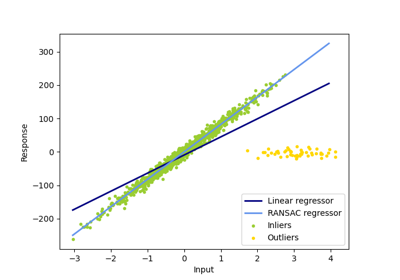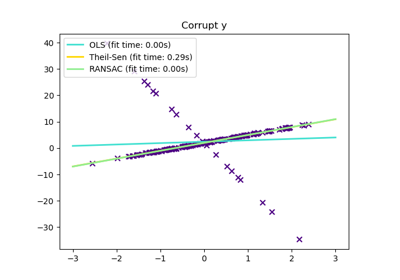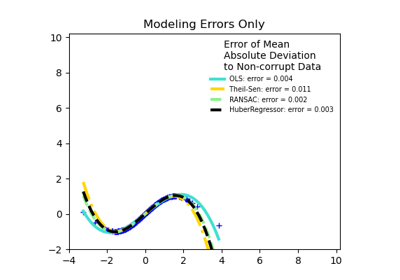sklearn.linear_model.RANSACRegressor¶
-
class
sklearn.linear_model.RANSACRegressor(base_estimator=None, *, min_samples=None, residual_threshold=None, is_data_valid=None, is_model_valid=None, max_trials=100, max_skips=inf, stop_n_inliers=inf, stop_score=inf, stop_probability=0.99, loss='absolute_loss', random_state=None)[source]¶ RANSAC (RANdom SAmple Consensus) algorithm.
RANSAC is an iterative algorithm for the robust estimation of parameters from a subset of inliers from the complete data set.
Read more in the User Guide.
- Parameters
- base_estimatorobject, optional
Base estimator object which implements the following methods:
fit(X, y): Fit model to given training data and target values.score(X, y): Returns the mean accuracy on the given test data, which is used for the stop criterion defined bystop_score. Additionally, the score is used to decide which of two equally large consensus sets is chosen as the better one.predict(X): Returns predicted values using the linear model, which is used to compute residual error using loss function.
If
base_estimatoris None, thenbase_estimator=sklearn.linear_model.LinearRegression()is used for target values of dtype float.Note that the current implementation only supports regression estimators.
- min_samplesint (>= 1) or float ([0, 1]), optional
Minimum number of samples chosen randomly from original data. Treated as an absolute number of samples for
min_samples >= 1, treated as a relative numberceil(min_samples * X.shape[0]) formin_samples < 1. This is typically chosen as the minimal number of samples necessary to estimate the givenbase_estimator. By default asklearn.linear_model.LinearRegression()estimator is assumed andmin_samplesis chosen asX.shape[1] + 1.- residual_thresholdfloat, optional
Maximum residual for a data sample to be classified as an inlier. By default the threshold is chosen as the MAD (median absolute deviation) of the target values
y.- is_data_validcallable, optional
This function is called with the randomly selected data before the model is fitted to it:
is_data_valid(X, y). If its return value is False the current randomly chosen sub-sample is skipped.- is_model_validcallable, optional
This function is called with the estimated model and the randomly selected data:
is_model_valid(model, X, y). If its return value is False the current randomly chosen sub-sample is skipped. Rejecting samples with this function is computationally costlier than withis_data_valid.is_model_validshould therefore only be used if the estimated model is needed for making the rejection decision.- max_trialsint, optional
Maximum number of iterations for random sample selection.
- max_skipsint, optional
Maximum number of iterations that can be skipped due to finding zero inliers or invalid data defined by
is_data_validor invalid models defined byis_model_valid.New in version 0.19.
- stop_n_inliersint, optional
Stop iteration if at least this number of inliers are found.
- stop_scorefloat, optional
Stop iteration if score is greater equal than this threshold.
- stop_probabilityfloat in range [0, 1], optional
RANSAC iteration stops if at least one outlier-free set of the training data is sampled in RANSAC. This requires to generate at least N samples (iterations):
N >= log(1 - probability) / log(1 - e**m)
where the probability (confidence) is typically set to high value such as 0.99 (the default) and e is the current fraction of inliers w.r.t. the total number of samples.
- lossstring, callable, optional, default “absolute_loss”
String inputs, “absolute_loss” and “squared_loss” are supported which find the absolute loss and squared loss per sample respectively.
If
lossis a callable, then it should be a function that takes two arrays as inputs, the true and predicted value and returns a 1-D array with the i-th value of the array corresponding to the loss onX[i].If the loss on a sample is greater than the
residual_threshold, then this sample is classified as an outlier.New in version 0.18.
- random_stateint, RandomState instance, default=None
The generator used to initialize the centers. Pass an int for reproducible output across multiple function calls. See Glossary.
- Attributes
- estimator_object
Best fitted model (copy of the
base_estimatorobject).- n_trials_int
Number of random selection trials until one of the stop criteria is met. It is always
<= max_trials.- inlier_mask_bool array of shape [n_samples]
Boolean mask of inliers classified as
True.- n_skips_no_inliers_int
Number of iterations skipped due to finding zero inliers.
New in version 0.19.
- n_skips_invalid_data_int
Number of iterations skipped due to invalid data defined by
is_data_valid.New in version 0.19.
- n_skips_invalid_model_int
Number of iterations skipped due to an invalid model defined by
is_model_valid.New in version 0.19.
References
Examples
>>> from sklearn.linear_model import RANSACRegressor >>> from sklearn.datasets import make_regression >>> X, y = make_regression( ... n_samples=200, n_features=2, noise=4.0, random_state=0) >>> reg = RANSACRegressor(random_state=0).fit(X, y) >>> reg.score(X, y) 0.9885... >>> reg.predict(X[:1,]) array([-31.9417...])
Methods
fit(X, y[, sample_weight])Fit estimator using RANSAC algorithm.
get_params([deep])Get parameters for this estimator.
predict(X)Predict using the estimated model.
score(X, y)Returns the score of the prediction.
set_params(**params)Set the parameters of this estimator.
-
__init__(base_estimator=None, *, min_samples=None, residual_threshold=None, is_data_valid=None, is_model_valid=None, max_trials=100, max_skips=inf, stop_n_inliers=inf, stop_score=inf, stop_probability=0.99, loss='absolute_loss', random_state=None)[source]¶ Initialize self. See help(type(self)) for accurate signature.
-
fit(X, y, sample_weight=None)[source]¶ Fit estimator using RANSAC algorithm.
- Parameters
- Xarray-like or sparse matrix, shape [n_samples, n_features]
Training data.
- yarray-like of shape (n_samples,) or (n_samples, n_targets)
Target values.
- sample_weightarray-like of shape (n_samples,), default=None
Individual weights for each sample raises error if sample_weight is passed and base_estimator fit method does not support it.
New in version 0.18.
- Raises
- ValueError
If no valid consensus set could be found. This occurs if
is_data_validandis_model_validreturn False for allmax_trialsrandomly chosen sub-samples.
-
get_params(deep=True)[source]¶ Get parameters for this estimator.
- Parameters
- deepbool, default=True
If True, will return the parameters for this estimator and contained subobjects that are estimators.
- Returns
- paramsmapping of string to any
Parameter names mapped to their values.
-
predict(X)[source]¶ Predict using the estimated model.
This is a wrapper for
estimator_.predict(X).- Parameters
- Xnumpy array of shape [n_samples, n_features]
- Returns
- yarray, shape = [n_samples] or [n_samples, n_targets]
Returns predicted values.
-
score(X, y)[source]¶ Returns the score of the prediction.
This is a wrapper for
estimator_.score(X, y).- Parameters
- Xnumpy array or sparse matrix of shape [n_samples, n_features]
Training data.
- yarray, shape = [n_samples] or [n_samples, n_targets]
Target values.
- Returns
- zfloat
Score of the prediction.
-
set_params(**params)[source]¶ Set the parameters of this estimator.
The method works on simple estimators as well as on nested objects (such as pipelines). The latter have parameters of the form
<component>__<parameter>so that it’s possible to update each component of a nested object.- Parameters
- **paramsdict
Estimator parameters.
- Returns
- selfobject
Estimator instance.



